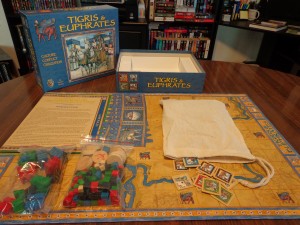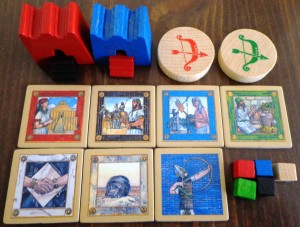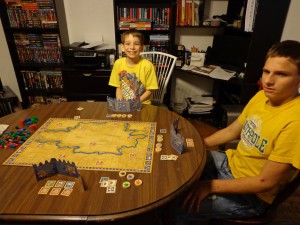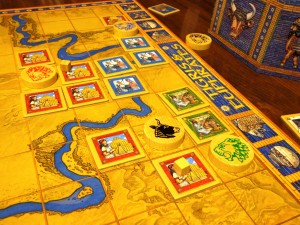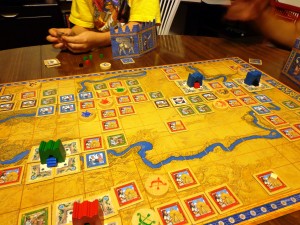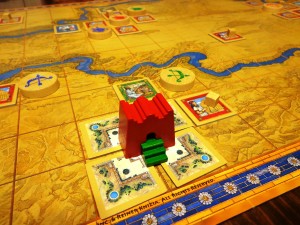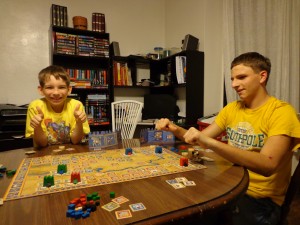Tigris & Euphrates…the day has finally come. I was looking at this game for months but was always at ends in regards to buying it. It received a lot of high praise, but I was worried that its depth would overwhelm the kids. Now that I’ve been reviewing games with them for just under a year, it was time to flex our muscles a bit to see if we were up to the challenge.
Editor’s Note: Despite the player limits mentioned on the box, it is my opinion that the game works perfectly fine as a two player game.
In Tigris & Euphrates, each player will take on the role of a dynasty. Each dynasty will be tasked with advancing their civilization in four key areas: settlements, temples, markets, and farms. The player that can advance all four aspects of their civilization the most while maintaining a good balance between them will win the game. Let’s take a quick look at the components and gameplay before we head into the review.
Components
Dynasty Tiles – These square tiles include pictures that represent the dynasties that players have chosen. They stay near their respective players to remind everyone on who is what dynasty.
Civilization Tiles – These square tiles come in red (temples), black (settlements), green (markets), and blue (farms). Players will be placing these on the board during the game to earn themselves victory points and to expand regions / kingdoms. They are also used during conflicts, but more on that later.
Leaders – Each player will receive four leaders, one of each of the four civilization tile colors. Whichever player picks the “archer” symbol as their dynasty, for example, receives a red archer, black archer, green archer, and blue archer piece.
Catastrophe Tiles – Players receive two of each and can be used to obliterate a particular civilization tile.
Unification Tiles – Players receive one of each and use them when they place a tile that joins two separate kingdoms. They are placed on the tile joining the two kingdoms until all external conflicts have been resolved.
Monuments – Monuments are two different colors and when placed, provide the appropriate players with a steady stream of victory points.
Victory Point Counters – These cubes come in the same four colors as the civilization tiles and are awarded to players as they earn victory points of a particular color.
Treasures – These unpainted (tan-colored) cubes are placed on the initial ten red civilization tiles. They serve as “wild cubes” for players to collect to add to their victory points to represent whichever color they wish.
Screens – Each player will have a screen so as to hide their tiles and victory point cubes from other players.
Game Board – The board is made up of land and water spaces where civilization tiles and leaders will be placed. The version of the game I bought has a two-sided board, one for the standard game and one for the advanced game.
Ziggurat Tiles, Civilization Buildings, Tower – These pieces are used during the advanced game. I’ll be covering the standard game to keep the review moving, but will link the manual later so that you can see what they do.
Setup & Gameplay
Players will begin by placing ten red civilization tiles on the spots already marked on the board. One treasure cube is placed on top of each one. Each player picks a dynasty and receives the appropriate dynasty tile, along with four leaders of that symbol (one of each color). They also receive six random civilization tiles, two catastrophe tiles, one unification tile, and a player screen.
On a player’s turn, they will perform two of the following actions:
1. Place, move, or remove a leader.
2. Place a tile and if warranted, distribute a victory point.
3. Play a catastrophe tile.
4. Swap up to six tiles.
Players can take the same action twice, should they wish.
It sounds simple, but there’s a few things to keep in mind when players perform the above actions. I’ll hi-lite the main points below, but will try not to prattle on about specifics.
*A region is a group of one or more adjacent tiles without a leader. A kingdom is a group of one or more adjacent tiles with a leader.
*A leader must be placed on an empty space that is next to a red tile (temple). If at any point the last red tile next to a leader is removed (or what have you), it returns to the current player. Also, leaders cannot be placed in a way that it would unite two separate kingdoms, and it cannot be placed adjacent to another leader or onto a river space.
*Blue tiles (farms) can only be placed on water whereas red, black, and green tiles can only be placed on land. If a tile is placed adjacent to a kingdom that contains a leader of the same color, a victory point cube of that color is awarded to that player. If there is no leader of that color BUT there is a black leader present, the owner of the black leader may be awarded the point.
*Kingdoms can have multiple leaders present and can co-exist peacefully so as long as two of the same color aren’t present. If a player places a leader of a color that matches the color of another leader already present in that kingdom, then an “internal conflict” is resolved. To resolve this type of conflict, players add up how many red tiles that their leader is adjacent to and add to that any number of red tiles from their hand. Whoever has the most tiles wins, with ties going to the defender. The winner receives a red victory point cube and the loser must remove their leader from the board. Any red tiles played from the players’ hands are discarded from the game.
*If a tile is placed that causes two kingdoms to join as one, a unification tile is placed over it temporarily until any external conflicts are resolved. “External conflicts” occur when one or more leaders of the same color now exist in this newly formed kingdom. Each conflict is resolved separately by adding up the tiles of that color in both kingdoms. Players can add tiles from their hand to add to the count, so as long as those tiles are the same color as the leaders in the conflict. Whoever has the most wins, with ties going to the defender. The loser must remove their leader AND all of those colored tiles from their side of the kingdom (which are discarded). The winner receives victory point cubes equal to however many tiles were removed in this fashion.
*Monuments can be built if four, same colored tiles are placed in a way that form a large square. One of the colors of the monument must match the tiles that formed the square. A monument generates victory points and awards players for every same colored leader they have in that kingdom on their turn. The black leader does not earn points from a monument in the way it does from tiles if leaders are absent, though it does collect them normally if one of the monument colors is black.
*Treasures are awarded to a player if they join two regions / kingdoms that have treasures on them AND if they have a green leader on that newly formed kingdom. If another player has a green leader there, they collect the treasure instead. Only one treasure is collected in this manner, the other is left behind in case it joins with another kingdom that has a treasure.
Game End & Scoring
The game ends when there are only one or two treasures left OR if a player cannot refresh their hand up to six tiles after they take their turn.
Players take a look at their cubes and take the value of the lowest color…which becomes their final score, no matter how much they might have of another color. Whoever has the highest score wins! Ties are broken by comparing the next lowest set of cubes and so on.
The above is simply an overview of the game and doesn’t cover all of the rules, though you can check out the manual for further information here:
The Review
If I could compare this game to anything else in my collection, it would have to be a mash-up of Acquire, Ingenious, and Chess. The tile laying mechanics and the way external conflicts are resolved remind me a little of Acquire, the endgame scoring mechanic reminds me of Ingenious, and the overall strategic depth that this game offers reminds me of Chess. Like in Chess, it’s easy to move a piece, but the real experts are able to see moves ahead to determine if it would actually benefit them to do so. As a former member of the USCF and a Chess tutor, it was easy for me to see just how deep the gameplay in this game actually is. I caught myself planning my move as I would in Chess…that is…”If I move my knight here, then this, this, and that could happen.” Some beginners, like myself, won’t be able to see all of the options open to them, but that is all part (and the fun) of the learning experience.
With all of that said, Tigris & Euphrates may not appeal to everyone. There are those who prefer easier games that require less thought, which is absolutely one hundred percent fine…each to their own, right? I know a few people who hate Chess because there is “too much thinking involved” but love games like Yahtzee and Sorry. If you’re a casual gamer that tends to leave the more complex games on their shelf, then Tigris & Euphrates may not be for you. This game really shines when players take the time to learn its ins and outs, and those who aren’t interested in doing so may either become frustrated or find another game that will hold their attention. That’s not to say that casual players can’t or won’t enjoy it, and that’s not to say that hardcore gamers will take it heart as the “best game ever.” The individual in question will have to be the one to ultimately make that decision. If you’re on the fence, my suggestion is to read the manual and see what kind of reaction you get. That’s how I decided to take the plunge…after reading the online manual, the game ended up being less complicated than I thought it would be.
The components are well made and the extras that came for the advanced game are a welcome bonus. My only complaint is that the monuments were a pain to put together. I’m not exactly the world’s craftiest person (there’s a reason why I’m an accountant) so it took me a good ten minutes to figure out the easiest way of jamming / sliding the steps into the monuments without breaking anything. Once they came together though, all was well.
If you want a parent’s perspective, this game will certainly help to hone critical thinking skills. Whether or not your kids will enjoy it is a different matter. Vinnie (11) required some coaching…a lot of, “are you sure you want to do that” moments like during our chess games. Despite the learning curve, he did very well and even put some thought behind some of his moves. Anthony (16) thought the game was too long and was upset at times over the results of some of our external conflicts…they turned out to be a huge game changer that set him back for a while. Playing games with your kids where hostile takeovers are almost a necessity can be difficult to do, especially if feelings are easily hurt. In the end, I was able to keep the mood light enough to where tempers didn’t flare and ruin the evening.
Overall, it’s a wonderfully deep game that I intend to experiment with as time permits.
Final Verdict: 8/10

